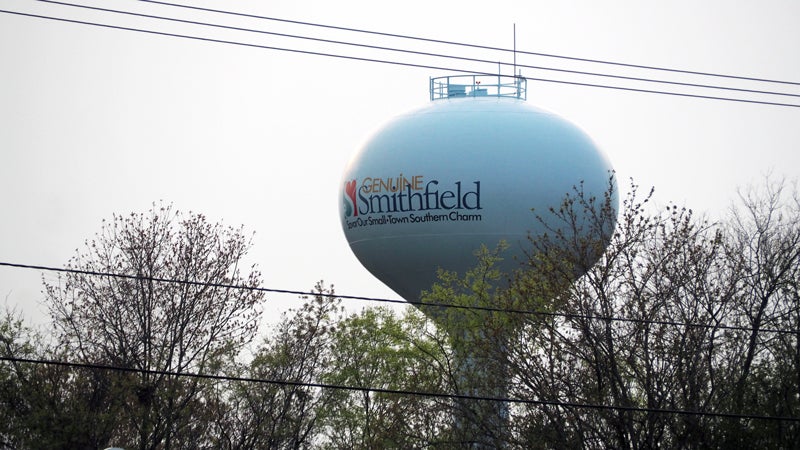Smithfield draft budget would hold tax rate, increase water and trash fees
Published 5:39 pm Thursday, May 9, 2024

- The town of Smithfield is considering a water rate increase in its draft 2024-25 budget.
Smithfield residents can weigh in on the town’s proposed 2024-25 budget at a 6 p.m. public hearing on May 28.
The $11.2 million budget Town Manager Michael Stallings published on May 1 would amount to a 9.3% increase over the $10.2 million budget the Town Council adopted for the current fiscal year.
Stallings’ budget projects real property tax revenues will increase by $451,700, or 13%, despite the town’s real estate tax rate of 16 cents per $100 in assessed value remaining unchanged. No other tax rate increases are proposed, though Stallings has included proposed hikes in the town’s water/sewer rate and trash collection fee, which he’d previously discussed with the council in March.
Smithfield enacted a monthly $9.70 trash pickup fee in 2020 and reduced the fee in 2021 to the current $6.01, or $72.10 per residence per year, when the town discontinued curbside recycling. Stallings is proposing to increase the fee 6% to $74.63 per residence per year to keep pace with what Smithfield pays its curbside trash contractor, Bay Disposal. Currently, the town pays Bay $82.20 per residence per year, and will be billed $87.12 per residence per year come July 1.
The net increase per household would be $2.53 per year, Stallings said.
The town’s water rate currently is $6.75 per 1,000 gallons plus a bimonthly $11.47 meter fee. Stallings is proposing to increase the rate 25 cents, or 3.6%, to $7 per 1,000 gallons to keep pace with the rising cost of chemicals and equipment used at the town’s reverse osmosis water treatment plant on South Church Street. The town’s sewer rate, which is based on water usage, would rise from $3.74 per 1,000 gallons to $3.99.
Even with the proposed increase, the town’s water rate would remain well below Isle of Wight County’s, which charges a $33.14 bimonthly meter charge plus $12.35 per 1,000 gallons and is proposing its own 5% rate increase to $12.96.
The budget proposes three new town employees, two in the Police Department and a safety officer under Human Resources who would be tasked with overseeing federal Occupational Safety and Health Administration compliance. According to Stallings, when the town’s previous safety officer left several years ago, those duties were rolled into other job descriptions, and are now proposed to again be a separate position.
The budget also proposes 4% pay raises for existing employees that would provide minimum $1,000 salary increases and raise the town’s minimum hourly wage from $12.50 to $15. The budget further proposes longevity bonuses that would increase an employee’s annual salary by $500 for one to five years of service, $1,000 for six to 10 years and $1,500 for 11 or more years.
In 2022 and prior, the town would pull several hundred thousand dollars from its cash reserves to balance its operating budget, but an uptick in interest income has eliminated the need for the subsidy, according to Stallings. The town, he said, has roughly $9 million, or nearly 100%, of its annual budget on hand in its unassigned fund balance – an amount far in excess of the typical 20% municipalities try to keep on hand in reserve.
The budget’s five-year capital improvements plan, which is intended for costly one-time expenses, lists $2.8 million for projects set to begin in 2024-25. The costliest include $696,790 for a concession stand serving the Luter Sports Complex’s football field, $850,000 for stormwater and drainage projects on Pagan and Battery Park roads, $175,000 for new police vehicles, a $170,000 bypass sewer pump, and $136,000 for the town’s share of the Park-to-Park Trail, intended to eventually connect Nike Park in Carrollton with Windsor Castle Park.
The CIP budgets an additional $100,000 per year for the Nike Park trail in fiscal years 2026-27 and 2027-28, and $675,000 in fiscal year 2028-29.
According to Stallings, the $136,000 budgeted for the upcoming year is grant funding for what he termed a “community action plan.”
“This will allow the Town to develop a pedestrian and bicycle mobility plan for the Town,” Stallings said. “Once that plan is complete, it will allow us to apply for Safe Streets For All funding for the construction of the project.”
Safe Streets and Roads For All is a federal program established by the 2021 Infrastructure Investment and Jobs Act, more commonly preferred to as the Bipartisan Infrastructure Law. The congressional funding package earmarked $5 billion through 2026 for the Safe Streets program. Over $3 billion is still available, according to the federal Department of Transportation’s website.
A $23 million proposal for funding Smithfield’s 1-mile portion of the trail from the Royal Farms on South Church Street to Windsor Castle Park scored poorly on an application last year for the fifth round of Smart Scale, a cost-versus-benefit formula the Virginia Department of Transportation uses to prioritize state funding. The county completed its 3.1-mile stretch of trail for $8.6 million in 2021, but Smithfield’s share is being driven up by the need to rebuild a two-lane stretch of South Church Street engineers have told town officials is too flat to accommodate curb-and-gutter drainage infrastructure for the proposed trail.
“The trail can’t move forward without the entire South Church Street project due to the need for stormwater improvements along the corridor,” Stallings said. “The funding in the CIP is to ensure we keep the project moving, but the amount in the CIP will not fully fund the project. We will have to secure additional funding through grants or VDOT for this project.”





